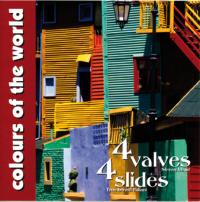Colours of the World Review by Peter Bale
Although frequently attributed to other people, it was the composer and music critic Constant Lambert who said in 1934 “The whole trouble with a folk song is that once you have played it through there is nothing much you can do, except play it over again and play it rather louder”.
Equally, the question of what constitutes a folk song can raise almost as much controversy as what constitutes a hymn arrangement or spiritual item suitable for a band contest. Even the great composer Richard Strauss was caught out when he included “Funiculi, Funicula” in his tone poem “Aus Italien”, not realising that it was in fact a commercial song, written to mark the opening of the new railway system.
For his second collaboration with the Italian group Trombonisti Italiani Steven Mead has come up with the idea of featuring music - mainly folksongs - from around the world, and not only is the music international, so also is the list of arrangers involved in the project. Between the twenty-two tracks, eighteen countries are represented, mainly from Europe, but with Canada, the USA, Israel (not in Europe, despite its presence at the Eurovision Song Contest!) and Japan also included. Thirteen tracks feature Steven accompanied by the trombones, and the other nine are performed by various combinations of multi-tracked euphoniums, all played by Steven himself.
Several of the pieces will be familiar, and not only the melodies themselves, but also the arrangements. Representing Ireland, “The Londonderry Air” appears in an adaptation of one of Percy Grainger's harmonisations, whilst the English contribution is the march “Folk Songs from Somerset” from his “English Folk Song Suite”, originally written for military band. Dating from 1923, the tunes featured are “Blow away the Morning Dew” and “High Germany”, and it transfers remarkably well to the new instrumentation, although the brisk ascending euphonium run at the end, impressive as it is as a musical feat, seems somehow out of place.
Maurice Bale's “A Celtic Frolic” draws together a number of Scottish melodies (and one Irish!), and incorporates a representation of bagpipes in the central section, featuring the intricate grace notes employed when moving from one note to another, and adjustments to the tuning to account for those notes which do not fit into the standard scale. Maurice is also responsible for several of the uncredited transcriptions, including the other contribution from the British Isles, the Welsh tune “David of the White Rock”. In this version, the euphonium opens in a low register, before moving upwards, allowing for a spectacular soaring phrase and exultant final note.
In 1916, the Spanish composer Enrique Granados met an untimely end, aged just 49, following the sinking of the boat in which he had just returned from the USA. Although much-loved by guitarists, he wrote mainly for the piano, and “Andaluza” is taken from volume two of his “Spanish Dances”. Although betraying its pianistic origins, it has again been transferred effectively onto brass, the opening stately and majestic, with alternate phrases contrasting the light tone of the trombone with the darker hues of the euphonium.
As for the other items with a Spanish flavour, “Zapateado”, a clog dance by Pablo de Sarasate, must have called for some pretty agile dancers, if they were to retain their footing in wooden shoes at such a breakneck speed. “La Cumparsita” comes from Argentina, opening with the soloist unaccompanied, with the trombones entering one by one, before picking up the tempo with the familiar tango melody, the performance being particularly notable for the tight rhythms of the trombones.
“Battagliero” from Italy is given something of an Air Varie treatment, opening with a euphonium cadenza and plenty of running quaver passages, whilst Austria's “Koa Koatlacker” comes across as a combination of Austrian march and hunting celebration, with an answering counter melody from the euphonium in the trio section. Moving to northern Europe, Hugo Alven's “Valflickans Dance” offers Steve the chance to show how adept he is at coping with the flurries of notes in the outer sections, contrasting with the smooth legato of the central segment. Reinhold Gliere's “Russian Sailor's Dance” from the ballet “The Red Poppy”, generally accepted as the first ballet of the Russian Soviet era, grows in excitement as the music develops, making for a fitting final item.
Of the pieces for euphonium and trombones, only two are not from Europe: Tameza Narita's “Hamabe No Uta”, from Japan, is otherwise know as the “Song of the Seashore”, and was made popular by the flautist James Galway, who chose it as the title track for an lp as long ago as 1979, since re-issued on cd. In contrast with the gentle lilt and pentatonic overtones of the music from Japan, the “Stephen Foster Melody” draws together a number of the American composer's most popular melodies, including “Oh Suzanna”, “Old Folks at Home” (played in an up-tempo ragtime version), “Beautiful Dreamer” and “My old Kentucky Home”. The treatment reminds one of recordings made by groups which specialise in nineteenth century Americana, such as the Chestnut Brass Company
The remaining items are played on euphonium alone, sometimes with just a melody line, and sometimes using multi-tracking, of which Steven is a master. On this occasion, however, he eschews mere display for its own sake, in most cases letting the melodies speak for themselves, and the effect is frequently quite moving. A couple of tracks display the vibrancy of Eastern European folk music, with its complex rhythms, whilst Russia's “Tears” has a suitably melancholy feel to it, and Canada's “The Red River” could have come straight from the sound track of one of televisions epic programmes on the Wild West.
The documentation for this issue is very basic, with a brief programme note in German, English, Italian and Japanese, whilst Steven's website gives details about the individual tracks that are not shown on the cd cover. On the other hand in this instance the music really does stand on its own merits (regardless of whether or not one can truly term it “folk” music!), and prospective purchasers should not be put off. Despite some of the 22 tracks being very short, the programme does not seem disjointed, and there is plenty of variety to maintain the interest of the listener.
Peter Bale - CD Review - www.4barsrest.com

Steven Mead and the Trombonisti Italiani

